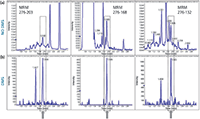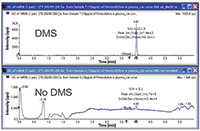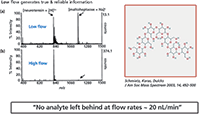Recent Developments in Ion Mobility Mass Spectrometry for Bioanalysis
This article reviews recent developments that aim to address the conflicting demands for higher throughput, sensitivity, and selectivity in bioanalysis applications.
This article reviews recent developments that aim to address the conflicting demands for higher throughput, sensitivity, and selectivity in bioanalysis applications.
Bioanalysis is a key part of a candidate drug's pharmacokinetic and pharmacodynamic characterization. Liquid chromatography coupled with tandem mass spectrometry (LC–MS–MS) has been used widely by pharmaceutical laboratories over the past 30 years to quantify drugs and their metabolites in biological matrices. Numerous advances in instrumentation, technology, methods, and software during this period have led to significant improvements in speed, and sensitivity alone has increased by seven orders of magnitude.1

Photo Credit: Rafe Swan/Getty Images
Analyzing drugs in biological samples has always been challenging as a result of matrix effects or background interference, and researchers have tried to overcome this in the past with various method developments and sample preparation steps. More recently, addressing the issue has been complicated further by the need to increase sample analysis throughput, while at the same time being able to detect compounds at increasingly lower levels.
One approach has been to use ion mobility mass spectrometry (IMS), which combines ion separation techniques with mass spectrometry, including quadrupole or time-of-flight (TOF). IMS has been commonly used for the selective detection of compounds in biological samples.2,3 Ion mobility can operate at atmospheric pressure, unlike mass spectrometry, and this allows the incorporation of atmospheric pressure ionization.3 This enables additional selectivity during sample introduction, but IMS is typically too slow and not sufficiently rugged for quantitative bioanalysis applications.4
The development of multiple reaction monitoring (MRM) with triple quadrupole mass spectrometers has gained broad popularity over the past 30 years for its significant advantages, including improved selectivity and quantitative accuracy. In MRM mode, two stages of mass filtering are employed on a triple quadrupole mass spectrometer. In the first stage, an ion of interest (the precursor) is preselected in Q1 and induced to fragment by collisional excitation with a neutral gas in a pressurized collision cell (Q2). In the second stage, instead of obtaining full scan ms/ms where all the possible fragment ions derived from the precursor are mass analyzed in Q3, only a small number of specific fragment ions (product ions) are mass analyzed in Q3. This targeted MS analysis using MRM enhances the specificity and, with that, the lower detection limit by up to 100-fold (as compared to full scan ms/ms analysis) by allowing rapid and continuous monitoring of the specific ions of interest. This approach became the gold standard for many pharmaceutical laboratories, and the more recent development in MRM3 achieved further improvements in selectivity, by increasing the number of fragmentation steps.4
However, achieving the required levels of selectivity and speed for accurate bioanalysis remains challenging for even the most sensitive instruments. Typically, today's assays need to be able to detect compounds ranging from low ng/mL levels to pg/mL; at these levels it can be very difficult to separate out compounds of interest accurately from other compounds. Matrix interference can result in either unresolved peaks, or in high baselines. Unresolved components can be resolved through slower chromatography (longer gradients) or through additional sample clean-up, which is labour-intensive and slow, adding unwanted time and costs to the analysis. Pharmaceutical laboratories typically aim to complete each sample analysis in under two minutes, which is not possible with these extra steps, especially if peak integration then needs to be adjusted manually on a sample-by-sample basis. High baseline problems can have adverse impacts on the limits of quantitation (LOQ) and dynamic range.4
Therefore successful drug quantitation in complex matrices requires much greater selectivity than can be achieved with traditional instruments and methods. With the growing interest in large molecule biotherapeutics and tightening regulations on drug characterization, new approaches for more selective quantitative assays are required.
Recent developments in ion mobility technology have led to the development of effective differential ion mobility separation techniques, where the ion separation takes place in a cell integrated in the ion source region, directly in front of the curtain plate. Rather than separating ions in time as they cross the cell, the ions are separated in trajectory based on the difference in their mobility between the high and low field portions of the applied RF (see Figures 1 and 2).4 A second, compensation voltage is applied to correct the trajectory of the desired ions along the axis of the cell, while other ions will migrate away because of the difference in mobility.

Figure 1: Analysis of clenbuterol in urine. (a) This assay suffers from matrix interferences in all three MRM channels. (b) Using effective differential ion mobility separation techniques, with isopropanol as a chemical modifier, resulted in the reduction or elimination of interferences in all three MRM channels.
This results in a very robust, stable, and high-speed technique that enables the use of short MRM cycle times.4 It effectively provides orthoganol separation in between the LC and MS stages to remove background components, allowing accurate lower level compound detection.5 The separation can be further enhanced by the addition of chemical modifiers, such as isopropanol, to the gas phase.5

Figure 2: Pentoxifyline in protein precipitated plasma. Very high baseline is successfully removed with DMS, resulting in a 20-fold improvement in signal-to-noise ratio at 10 ng/mL.
Even with this approach, detection of compounds at the pg/mL level can still be challenging as ion suppression becomes a much greater issue. Another approach that is gaining interest for high throughput bioanalysis is combining micro LC with ion mobility MS. By using columns with diameters of under 1 mm, micro LC can offer fast separations with improved sensitivity. Micro LC also uses smaller diameter electrodes, which can minimize post-column dispersion, resulting in improved chromatographic resolution with narrower and higher peaks (see Figure 3).6

Figure 3: Low flow generates true and reliable information. Adapted and reproduced with permission from Springer and the Journal of The American Society for Mass Spectrometry, 14(5), 2003, Effect of different solution flow rates on analyte ion signals in nanoESI MS, or: when does ESI turn into nanoESI?, Andrea Schmidt, figure number 1. © Springer.
For bioanalysis applications, the lower flow rate and smaller diameter columns of micro LC help to increase the sample efficiency (or the ionization efficiency), which reduces ion suppression considerably. It also means that less sample needs to be injected, which also enhances sample efficiency and lowers ion suppression. Using micro LC also means that at least 10 times less solvent goes into the mass spectrometer (see Table 1 in reference 7), reducing solvent consumption, as well as reducing the costs, space, and paperwork associated with transporting hazardous waste products.7
Future Directions
Advances in MRM technology offer scope for improvements in resolution and performance, but instrumentation companies will continue to strive for better selectivity, enhanced sensitivity, and higher throughput. Further challenges will also arise from trying to keeping pace with newer bioanalysis methods, such as emerging trends in micro-sampling and micro-dosing (cassette dosing). These techniques have the potential to significantly reduce the sample volumes required in bioanalysis. For example, capillary blood microsampling can use just 8–10 μL blood for a single time point,8 but implementing these techniques introduces a number of new technical challenges.
References
1. T.R. Covey, The Column 9(16), 11–17 (2013).
2. A.B. Kanu, P. Dwivedi, M. Tam, L. Matz, and H.H Hill Jr, J. Mass Spectrom. 43, 1–22 (2008).
3. D.C Collins and M.L. Lee, Anal Bioanal Chem 372, 66–73 (2002).
4. Y. LeBlanc, D. Caraiman, M. Aiello, and H. Ghobarah, AB SCIEX technical note, publication no. 2960211-01 (2011).
5. J.A. Ferguson, P. Clemens, and L.Y. Olson LY (2013). "Evaluation of differential mobility techniques for quantitative and qualitative identification workflows in pharmaceutical environments," Poster #265 at the ASMS 2013.
6. A. Schmidt, Journal of The American Society for Mass Spectrometry14(5) (2003).
7. T. Settineri, The Column 8(15), 2–6 (2012).
8. Zane and Emmons, Microsampling in biopharmaceutical analysis (Future Science Ltd., London, UK, 2013).
9. Cen Xie, Dafang Zhong, Kate Yu, and Xiaoyan Chen, Bioanalysis 4(8), 937–959 (2012).
10. L. Dillen, W. Cools, L. Vereyken, W. Lorreyne, T. Huybrechts, R. de Vries, H. Ghobarah, and F. Cuyckens, Bioanalysis4(5), 565–579 (2012).
11. K. Mriziq, S. Hobbs, T. Settineri, and D. Neyer, Eksigent application note, publication no. 4590211-01 (2011).
Steve Taylor has worked in the pharma space for 30 years, both within large pharma companies, and with instrument suppliers. He is an analytical chemist by training and has a PhD in advanced characterization of complex mixtures. This gives Steve considerable practical as well as theoretical knowledge of chromatographic and MS systems and their integration. The first 25 years of his career were spent characterizing small molecules, and in the last five years he has followed the industry trend and moved on to the characterization of biopharmaceuticals. For the last two and a half years Steve has been the Market Development Manager for the pharmaceutical business for EMEA with AB Sciex.
E-mail: support@absciex.com
Website: http://www.absciex.com/applications/drug-discovery-and-development-mass-spec
This article is from The Column. The full issue can be found here:http://images2.advanstar.com/PixelMags/lctc/digitaledition/August22-2014-uk.html

Regulatory Deadlines and Supply Chain Challenges Take Center Stage in Nitrosamine Discussion
April 10th 2025During an LCGC International peer exchange, Aloka Srinivasan, Mayank Bhanti, and Amber Burch discussed the regulatory deadlines and supply chain challenges that come with nitrosamine analysis.








